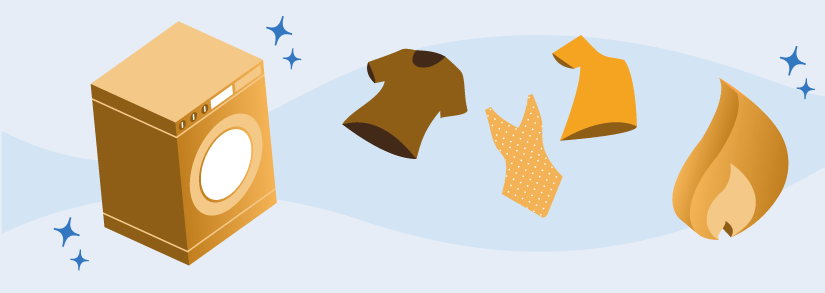Choosing and Buying a Clothes Dryer in Australia
Unlike many other home appliances, clothes dryers are not a necessity but they do make our lives easier. With Australia’s abundant sunshine, it’s easy to line-dry clothes and laundry at no cost (just a little solar energy). That doesn’t mean clothes dryers don’t make our lives much easier. Whether you want to add a clothes dryer to your list of home appliances for the first time or are looking to replace your old one, keep reading below to learn about clothes dryers.
Should I replace my clothes dryer?
Deciding if your clothes dryer has a few more years of life, or if it’s time to replace, can be a tough choice. If your clothes dryer is getting up there in years, or on the fritz, you’ll need to decide whether it’s worth the cost of repair. When deciding if it’s worth it to repair your current dryer, consider a few factors:
Repair vs replacement cost: As a general rule of thumb, if the cost of repairing your current dryer is more than half the cost of replacement, buy a new one. However, consider the value of your current dryer and what you is available in your budget as well. If the cost of repairing your current, high-efficiency dryer is $200, a similar, new, model might cost you $1,000 while a basic dryer might only cost you $300 upfront. While technically, yes, a new dryer is only slightly more than the repair cost, you’d be getting a less efficient model.
Age: The average life expectancy of a clothes dryer is between 13 and 14 years, with electric models lasting a little longer than their gas-powered counterparts. If your dryer is getting up there in age, it might be time to consider a new one. However, if your 12-year old dryer needs a simple, $100 repair, it might be worth the upfront cost to give you a few more years of life while researching a replacement.
Efficiency: If your dryer is an older model, it might not have the same energy efficient technology that newer clothes dryers have. Replacing your current dryer with a newer, more energy efficient one can save you money on energy costs over the next 13-14 years you’ll have it.
Size matters: If your family has recently changed in size, whether that means the kids have moved out or a new bundle of joy, or two, has joined the family, your laundry needs might have changed. Too-small dryers mean running more loads of laundry and thus wasting energy. Likewise, using too big a dryer will mean you’re using unnecessary amounts of energy on small loads of laundry. As a general rule, your dryer should be roughly twice the capacity of your washer.
How to buy the best clothes dryer
Dryers are a big investment. Imagine you are buying a new TV or a dishwasher. While choosing the cheapest model might seem like the best way to go, you could potentially be using your washer every day for 14 years, so doing your research and finding the best available option for you can make all the difference.
Different types of clothes dryers
While it might seem like all clothes dryers are the same, this is far from the case. Your first step to choosing a new clothes dryer is to decide if you want electric, or gas. If you have a gas connection in your house, opting for a gas-powered clothes dryer might be more expensive upfront, but they are more energy efficient and cheaper to run than their electric counterpart. However, if you’re interested in an electric dryer, there are a number of different types that dry clothes using different methods.
Gas clothes dryers: Gas dryers, as the name suggests, use gas to heat air. They are more expensive upfront but generally cheaper to run. Gas clothes dryers are generally not recommended for small apartments as they do need a vent to the outside.
Vented clothes dryers: Vented dryers are the most expensive to run, but also the most common. Electricity heats up air, which is vented into the clothes dryer. Once the air becomes moist it’s replaced with dry again. These vented clothes dryers can lead to moist air in your laundry room.
Condenser clothes dryers: Condenser clothes dryers are more expensive than vented dryers, but are also more efficient. They extract water vapor from the hot air, and recycle the air itself during the drying process.
Heat pump condenser dryers: The most expensive electric clothes dryer, but is among the most efficient of electric options. Since heat pump condenser dryers don’t vent hot air or water like vented or condenser clothes dryers, your laundry room will remain cool and dry.
Choose an energy efficient clothes dryer
Clothes dryers are inefficient and unless you’re willing to shell out over $1.5k for a new one, you probably won’t find a clothes dryer above a 3 star energy rating. The best way to increase the energy efficiency of your dryer is to avoid using it as much as possible. Australia, as a country, enjoys plentiful sunshine and most laundry can be hung to dry on warm and sunny days. Not only are you reducing your energy consumption, and utilizing natural solar energy to dry your clothes, but your clothes will last longer when dried naturally.
Other clothes dryer features
If you’re spending the money on a new clothes dryer, you probably won’t want a basic model. While getting cool features might seem unnecessarily expensive, they can make your life so much easier.
Programs: Not all clothes are the same, and you don’t want to dry all your clothes the same way. Steam features, delicate or wollens settings, air-tumble only, or other programs can make sure you’re treating all your clothes in a way that makes them last longer, and make sure that you’re using the right amount of energy for each load of laundry.
Auto-sensor: An auto-sensor shuts the dryer off automatically when it senses your clothes are dry. Not only will you avoid over-drying your clothes, but you’ll save on your energy bills by reducing the total amount of time the dryer is running.
Child safety: If you have little, curious, fingers, living in your house, a dryer with child-lock controls and child safety features can be invaluable. Child-lock means the dryer can’t be programmed without pressing a certain combination of buttons, and while auto-start might be a convenient feature for some, those who have little ones in the house a lot might want to avoid this specific feature as it is far too easy for a child to climb into the dryer and shut it behind them.
What size clothes dryer do I need?
When buying a new clothes dryer, it’s important to consider size. Depending on how many people live in your house and how often they wear and wash clothes, your clothes dryer needs will vary greatly.
Clothes dryers are measured in terms of capacity, referring to the weight of the clothes once dry. A 5kg clothes dryer, for example, can hold 5kg of dry clothes (approximately five towels, five full outfits including pants, socks, shirt, and underpants, or one single-size doona). When considering the size of a new clothes dryer, it’s a general rule of thumb that your clothes dryer drum should be quite a bit larger than your washing machine, approximately double the size.

Good Buyz offers a variety of sustainable smart home appliances and devices designed to work with renewable energy systems. Their range includes energy-efficient refrigerators, washing machines, smart thermostats, and lighting—all designed to reduce electricity use and integrate seamlessly with solar panels and battery storage. These products help you create a greener, more connected home by optimizing energy consumption automatically through smart controls and app-based scheduling.
Average clothes dryer prices
New clothes dryers are expensive, like any home appliance. But no matter if you’re buying a new refrigerator, air conditioner, or water heater, home appliances are also an investment meant to last you many years. Clothes dryers can start around $300 for a basic model, but this will not be nearly as energy efficient, nor last as long, as more expensive options.
| Vented Dryer | Condenser Dryer | Heat Pump Dryer | |
|---|---|---|---|
| Purchase price | $350-$600 | $600-$1000 | $1000+ |
| Star rating | 1-3 | 2-4 | 6-10 |
| Annual running cost (weekly use) | $80-$100 | $70-90 | $20-$50 |
| Annual running cost (daily use) | $580-$650 | $520-$630 | $150-$330 |
Source: energyrating.gov. Prices based on a 7kg model using 28.55c/kWh.
As shown above, while vented dryers (the traditional choice) are the cheapest option, they’ll also cost you the most to run. Conversely, the most energy efficient heat pump clothes dryer, while much more expensive, will cost you about half as much to run. If you rarely use your clothes dryer, whether it’s because you have a small household or prefer to line-dry your clothes, choosing the vented dryer might be a good choice. They’re less expensive upfront and with infrequent use you might still find the total lifetime cost to be less than if you opted for a more expensive, but more efficient, model.
Likewise, if you frequently use your clothes dryer, investing in a super efficient condenser or heat pump dryer might be a better choice. The extra money spent upfront will often pay itself back as you save more energy and cost over the 14 years you have the appliance.
Running cost of a clothes dryer
Clothes dryers are not energy efficient, and will cost you a pretty penny to use regularly. If you can get a more efficient model, you’ll save in the long run, but your best bet to reduce the running cost of your clothes dryer is to hand-dry your clothes as much as possible.
| Star-rating | Capacity | Uses per week | Annual cost |
|---|---|---|---|
| 2-stars | 5kg | 1 per week | $69.15 |
| 4-star | 5kg | 1 per week | $49.96 |
| 4-star | 7kg | 3 per week | $209.84 |
| 6-star | 7kg | 3 per week | $151.61 |
| 8-star | 7kg | 5 per week | $182.56 |
Source: Energy Rating Calculator
Cleaning your clothes dryer & extending its life
Clothes dryers are expensive and inefficient. Your best bet for keeping your dryer like-new for as long as possible, and as energy efficient as possible, is to clean it regularly.
Things you should do every time you use the clothes dryer:
Clean out the lint filter: Lint filters capture the fuzzies that come off of our clothes while they dry and must be cleaned after every use. Blocked lint filters greatly reduce your dryers efficiency, and are one of the biggest causes of clothes dryer fires.
Keep the door open: Keeping the door to the dryer open can extend the life of the door seal, and allow the interior of your dryer to stay fresh for longer.
Drain: If your clothes dryer has a water tank (for condenser or heat pump models), empty the tank after every use. Otherwise, make sure it’s attached to a drain that automatically empties.
It’s also important to give your dryer a quick wipe-down with a soft, damp cloth once a month and give it a proper cleaning once a year with a vacuum to make sure you get all the lint out of the vents and crevices. In addition, regular maintenance from a certified technician can keep it working for as long as possible.
Clothes dryer FAQ
What is the life expectancy of a clothes dryer?
The average life expectancy of a clothes dryer is between 12-15 years, with electric dryers generally lasting 13 and gas dryers lasting 14.
How to prevent clothes from shrinking in the dryer
We’ve all had a favorite sweater that accidentally ended up going into the clothes dryer, going in at a normal size and coming out like it was made for a doll. This is a frustrating experience, and unfortunately not much can be done about shrunk clothes.
When clothes are made, whether it’s a sweater, a pair of jeans, or what have you, the fiber in the fabric material is stretched out. These fibers are relatively short in their natural state, but become stretched when turned into your favorite t-shirt. When heat is applied to these fibers, they want to shrink again.
Natural fibers, such as cotton or wool, are the biggest culprit of this phenomenon. These types of fibers absorb water a lot more than synthetics, and the water they absorb helps lubricate the fibers, which makes them shrink more easily when exposed to heat.
Synthetics, and tightly woven fabrics, are less likely to shrink. This is why you can wash and dry your favorite pair of jeans and, while they might get a bit tighter (as they loosen up with wear), they won’t often shrink to a smaller size than when you first purchased it.
Unfortunately, it’s hard to avoid shrinkage. Clothes that are more susceptible to shrinkage such as sweaters should be air-dried, and always read the care label of your clothes. If you shouldn’t dry something, don’t dry it. There also isn’t much that can be done for clothes that have shrunk in the dryer. If your sweater has gone from the size of an adult male, to a doll, you really can’t fix it. However, for clothes that only shrunk a little bit (too tight around the midsection, or slightly shorter than when you bought it) you can usually get a centimeter of size back with a few tricks:
Cotton: Fill a bowl with lukewarm water and two tablespoons of hair conditioner. Soak the cotton clothing for 30 minutes. After 30 minutes, some recommend you rinse the conditioner out, while others say you should not. Either way, whether or not you rinse, lay the wet clothing flat on a towel and roll it up tightly so it’s damp and no longer soaking. Carefully unroll the towel, and lay the piece of clothing flat to dry while pinning the edges to make sure it remains stretched out.
Cashmere and other animal fibers: Similar to cotton, fill a bowl with lukewarm water and add 1-2 tablespoons (per one quart of water) of either Borax or vinegar. Soak the clothing for 30 minutes while occasionally stretching out the material while it’s submerged in the water. After 30 minutes, squeeze the excess water out. Instead of laying the clothing flat to try, animal-fiber clothing should be stuffed with towels to retain its shape.
Synthetics: This process is similar to unshrinking cotton, however you’ll only want to soak for 15-20 minutes in the conditioner and water mixture and avoid wringing the article of clothing dry. After 15-20 minutes, gently begin the stretching process using pins or heavy objects to weigh it down while the clothes air dry.
Denim: Denim doesn’t usually shrink unless blended with other materials. If your jeans do shrink, you have two options. Treat it like cotton and hang to dry after a water and conditioner soak, or put them on and sit in a lukewarm bathtub for 15 minutes and then walk, sit, and squat for another hour for them to stretch out again.
Click below to find a better deal for your home!

